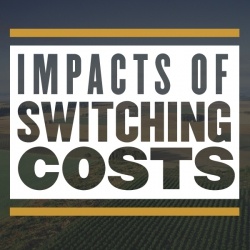 Article
Article
Blut, M., H. Evanschitky, C. Backhaus, J. Rudd, and M. Marck. “Securing Business-to-Business Relationships: The Impact of Switching Costs.” Industrial Marketing Management 52 (2016): 82-90.
Reviewer
Dr. Allan Gray, Executive Director and Professor
Summary
The purpose of this research paper was to examine the importance of switching costs in business-to-business markets. The authors identify three important types of switching costs: procedural, financial, and relational. The authors tested their theory with a sample of business-to-business customers’ actual behavior. Their tests revealed that relational switching costs were most important for securing business-to-business buyer-seller relationships. Enhancing relational switching costs increased the share of wallet from the customer and the cross-buying behavior of the customer while reducing their actual switching behavior.
What this means for agribusinesses
As the markets continue to consolidate at all levels of the food and agribusiness chain, the seller-buyer relationship increasingly looks and behaves like a business-to-business (B2B) market. In these consolidated markets, suppliers and customers alike are making more substantial specific asset investments that link their businesses more closely and the purchasing process is becoming more complicated. The pursuit of enhanced relationships between business partners in this B2B market is likely more critical than in a more fragmented market that behaves a bit more like a business-to-consumer market. The literature on B2B relationship marketing recognizes the importance of customer perceived value, customer satisfaction, and trust as critically important elements of establishing a strong business relationship. This research paper expands on this literature to look at the importance of switching costs in enhancing the B2B relationship.
Switching costs are the customer’s perception of the magnitude of additional costs required to switch from their current supplier to another supplier. Often we employ tactics aimed at trying to increase these switching costs for the customer. Tactics such as loyalty programs like Winfield Solutions’ Emerald Program for agricultural retailers or unique customer solutions like Cargill’s Feed Management System services for feed mills and animal producers who make their own feeds are good examples of offerings to increase customer switching costs.
To identify the critical dimensions of switching costs in a B2B setting, the researchers interviewed 38 customers who had recently switched service providers. They focused their interviews on the person in each company that had central responsibility for the switching decision. Through this set of highly structured interviews they identified three critical dimensions of switching costs: procedural, financial and relational.
Procedural switching costs are the costs associated with finding a new supplier. These costs include uncertainty costs, search and evaluation costs, costs of learning, and setup costs. Often, customers associate switching with the risk and uncertainty of potential negative outcomes from the switch. The more uncertain they are about the relative performance of the current and new supplier offerings, the higher their perceived switching costs (e.g., corn seed performance). Customers also see the time commitment to identify and evaluate new suppliers as costly. Often, switching suppliers might require the customer to develop new skills/expertise to effectively use the new product or service (e.g., financial accounting software). And finally, some customers see the time and effort required to relay their needs and information to a new supplier as costly.
Financial switching costs are more easily quantifiable. These costs include direct monetary costs such as fees to break contracts and/or initiation fees to adopt a new provider. More important are the perceptions of lost performance costs and sunk costs. Customers often perceive that switching will result in the loss of privileges and benefits, such as access to supplier expertise that helps lower the customer’s production costs (e.g., animal breeding technicians from the dairy’s genetics provider). Customers also recognize that often specific investments have been made in working with the current supplier that will be lost if they switch (e.g., specific hardware and software in precision agriculture).
Relational switching costs involve the loss of identification and emotional bonds with both the brand/provider and personal relationships between the people involved in the transactions. Customers often perceive a cost of breaking the bond with a brand they have been associated with (e.g., brand loyalty in farm machinery is often very strong in the agricultural markets). They also perceive a strong cost of breaking the personal relationships they have developed with the people they interact with from the supplier (Dupont-Pioneer Seed company’s agronomy specialists have long been known for creating strong personal relationships with their customers).
In the second half of the study, the researchers tested the effectiveness of each of the switching cost dimensions in customer purchasing behavior. The intent of the analysis was to determine how the switching costs’ dimensions affected not only switching behavior (a defensive strategy) but also the share of wallet and cross-buying behavior of the customer (offensive strategies). Their key finding was that relational switching costs were the most important switching costs. Relational switching costs were the only dimension that showed positive impacts in affecting actual switching behavior and relational switching costs had positive benefits on increased share of wallet (buying more of the product/service from the key supplier relative to competitors) and on increased cross-buying behavior (buying more products/services from the key supplier). Procedural and financial switching costs were not important in defending against switching, but procedural switching costs were associated with enhanced share of wallet while financial switching costs were associated more closely with cross-buying behavior.
Agribusiness companies seeking to enhance their B2B relationships with their customers would do well to identify the offerings and actions they pursue to enhance the perception of the three identified switching cost dimensions. The authors suggest that taking stock of your company’s current customer-perceived switching costs and designing strategies to allocate resources more strategically in these areas can be highly effective in enhancing customer purchase behavior.
To me, the most important implication of this research is the identification of relational switching costs as being so influential in the B2B relationship. As the agribusiness industry continues to move more toward a B2B industry, one might conclude that the idea of agricultural industry being a relationship business would become obsolete. This study would indicate quite the contrary. The importance of having a customer-facing team with the capabilities to provide a tailored explanation of how and where products and services add value for the particular customer is vitally important. Moreover, including discussions of how the product and service offerings can be linked to the customer’s systems and processes might lead to enhanced perceptions of switching costs and deepen the B2B relationship.
In addition, the study reinforced the importance of strong brands, even in a B2B setting. Strong brands often embody the key elements of customer-perceived value and trust. The insight from this study is that the establishment of these strong brands can also enhance the perceived switching costs for the buyer as they tend to associate their own business with brand. I would argue that the strong brands we see in the food and agricultural industry are likely prudent investments that will result in many customers staying with their trusted supplier even in more difficult markets like those we face today.



